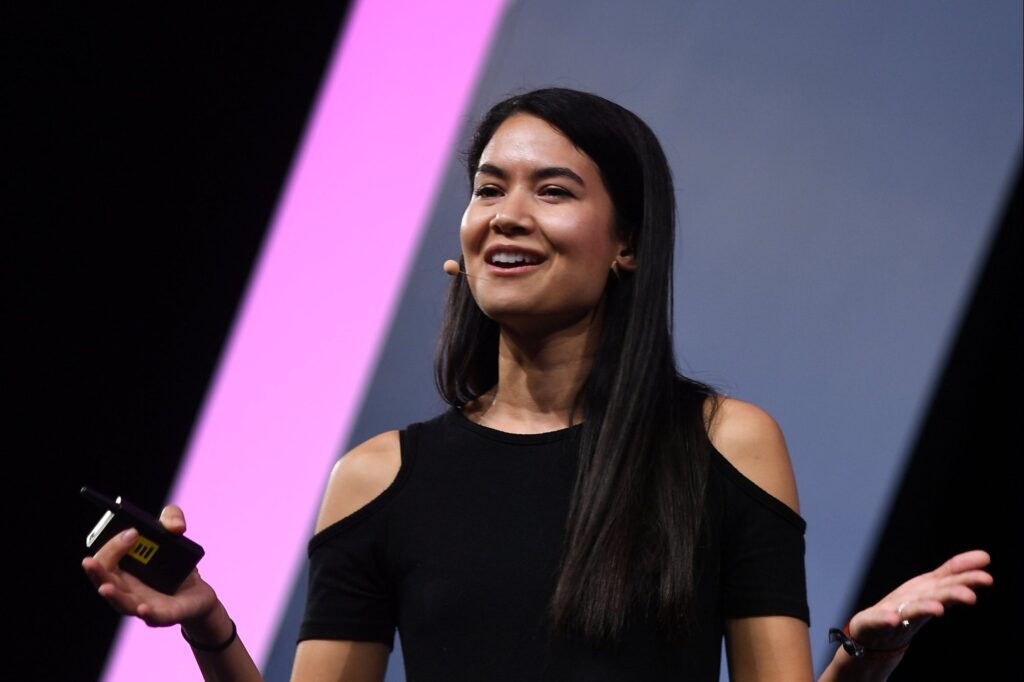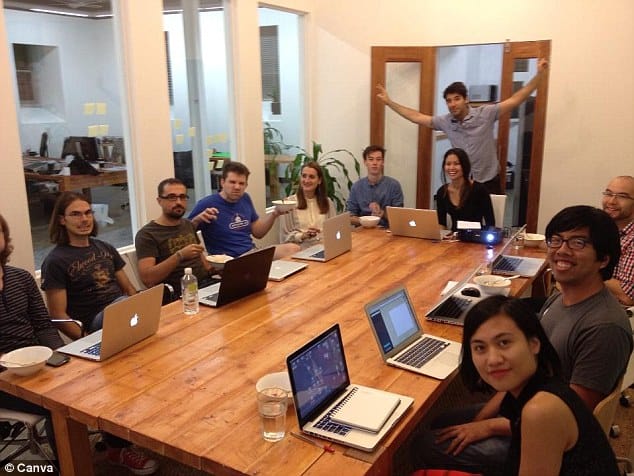When a young Melanie Perkins got inspired to build an online design tool, she was not privy to the upcoming challenges of 100+ rejections and finding herself adrift on a kiteboard in a plan to attract investments. Yet perseverance is all it takes; the young entrepreneur, propelled by her husband and business partner, Cliff Obrecht, would not have done it any differently even if she knew what the journey entailed. In the age of digital content, visuals have taken centre stage. From social media graphics to any field of academic project, design plays a crucial role in conveying ideas effectively. However, not everyone is a graphic designer, and that’s where Canva steps in.

Perkins’ design platform has not only democratised design but has also redefined the way an individual can create and communicate their ideas visually. This idea, though revolutionary, experienced a tough start, as many out-of-the-box ideas usually do. Perkins’ first venture into gaining support for this idea gave her over a hundred rejections and numerous dead-end trips to Silicon Valley.
Determination does not fold till you let it, and Perkins carried this ideal till she found herself amongst a group of kitesurfing venture capitalists at a pitch competition in Perth. She braved treacherous waves to build Canva, which today boasts a community of over 125 million people across 190 countries.
“It was like, risk: serious damage; reward: start a company,” Perkins says. “If you get your foot in the door just a tiny bit, you have to kind of wedge it all the way in.”
The Birth of a Game-Changer
The free-to-use, online design platform bloomed in the mind of Melanie Perkins when she was just 19 years old, teaching fellow students basic computer design as part of her communications and commerce studies. Perkins had a revelation when she realised how complex and tedious the simple act of designing and printing a poster can be: the available platforms from Microsoft and Adobe were hard to use and even harder to master. She conceptualised a design tool that will be simple, swift, and efficient. This is what gave rise to an early form of Canva – Fusion Books.

“People would have to spend an entire semester learning where the buttons were, and that seemed completely ridiculous. I thought that in the future it was all going to be online and collaborative and much, much simpler than these really hard tools,” Perkins relayed in an interview.
As her idea developed, Perkins and her then boyfriend and business partner, Cliff Obrecht, chose to target a niche but profitable area: school yearbooks. Soon enough, the startup gained traction, and Perkins had to put her studies on hold to commit to this new journey. With Obrecht and even Perkins’s mom holding the fort, the business eventually reached over 400 schools. Fusion Books’ licences were being sold as far as France, backed by students who desperately needed it.
But Perkins wanted to go farther with her big dream, and venture funding proved crucial. This was especially hard in a place like Perth, a city built more for mining than tech business ventures. Perhaps propelled by this very fear, Perkins immediately seized an opportunity in 2011 when she came across renowned venture capitalist Bill Tai. The founders became fixtures at Tai’s subsequent kitesurfing gatherings, which featured prominent tech executives looking to invest in new startups.
Bridging the Design Gap: the idea gains focus
Though Tai’s connection provided a new hill to trek on, the reach to the top was still undetermined. The cofounders enthusiastically explained the idea behind Canva Chef; a metaphorical pizza with design elements as the toppings and document types—flyer, business card, restaurant menu—as the dough. The idea fell short with many investors, and their trips to Silicon Valley gave way to worse prospects as well. But these excursions into Tai’s gathering weren’t all futile; and Perkins soon met Cameron Adams, a former Google designer who had founded a startup based in Sydney.

Soon Adams’ signed as the third co-founder in 2012, and with a technical leader, the business finally broke through. One of Canva’s primary objectives was to bridge the design gap. Before Canva, creating eye-catching graphics required a level of skill and software proficiency that most people simply didn’t have. Canva’s user-friendly platform provides an intuitive drag-and-drop interface, a vast library of templates, and a rich selection of design elements. This means that virtually anyone, regardless of their design experience, could now produce professional-looking materials.
This steady undertaking soon got Canva $3 million in seed funding in two tranches in 2012 and early 2013, including a crucial matching grant from the Australian government. The company finally launched in August 2013, and while the start was a bit shaky, the timing was immaculate. With the rise of social media platforms like Instagram and Twitter; every venture – be it creative, academic, or business-related, needed an aesthetically pleasing online presence. Since its launch, the platform has helped create over 8 billion designs, proving how much people rely on its prowess.
An efficient and affordable way to design
Canva’s key advantage over industry giants like Adobe or Microsoft is its user-friendly and easy-to-use tools. In the first month of its anticipated launch, it saw over 50,000 sign-ups, and by the next year, it had raised another $3 million from Thiel’s Founders Fund and Shasta Ventures. In 2014, Canva’s stats were already amazing, with over 3.5 million designs made by 600,000 users.
While Canva had a slow start, it is surely targeting every sector. This in turn ensures that the company is not constrained by the market sentiments of any particular vertical. While most of Canva’s features are free-to-use and attract millions of customers, it also provides great premium plans. These diverse revenue streams play a key factor in its growth. Its ‘freemium’ plans have expanded across Canva for Enterprise, Print and Merchandising, Canva for Education, and even a content marketplace that allows designers to sell their creations, earning a share of the revenue while Canva takes a commission.

In 2018, Canva became Australia’s first unicorn of the year after raising $40 million, which pushed the company’s value over $1 billion. In October 2019, a $85 million funding round led by Silicon Valley investor Mary Meeker’s Bond Capital gave the company a valuation of $3.2 billion. Perkins used this new capital growth to expand Canva’s team of 700 across Manila, Sydney, and Beijing.
The CEO has her own ways of breaking the ice when she onboards the recruited employees. Perkins gives a rundown of Canva’s most sensitive financial numbers and past investor pitch decks to explain her conviction that one can grow a global tech giant from anywhere in the world, despite the limited connections or prospects.
“Melanie is a rare breed of entrepreneur, the likes of which you don’t find often anywhere,” said Mary Meeker, one of Canva’s investors, about the CEO.
A resilient fight despite the obstacles
The tech industry is without a doubt still a very male-dominated sphere. Perkins fight is not just her own, and she’s made extensive efforts to eliminate gender disparity. She started off with what she has reigned over; working hard to ensure that there was no hiring bias at Canva. A testament to her efforts is Canva’s female representation, which is at 41%, much higher than the 28% industry average.
The startup had to deal with many setbacks, one of the most jarring of which occurred in May 2019. Days after Canva announced Mary Meeker’s $70 million funding, a hacker breached Canva’s systems. The hacker had downloaded almost 139 million user names and email addresses; which sent the company in a flurry to deal with the disaster. Following Mike Cannon-Brookes and Scott Farquhar’s (Atlassian’s co-founders) advice, Perkins and Obrecht called the FBI and launched a formal review. Canva didn’t fall short; just in two weeks, they announced two-factor authentication for their users, supported by their users’ trust.
Canva’s trajectory remains steady despite the difficulties. Last year, the company announced its wish to expand into the $1.7 billion website builder market. Competing with Wix and Squarespace, the company is responding to the rising demand for visual content with Canva Websites. Along with its forevermore affordable nature, it offers users the ability to easily build and launch a free one-page website.
Conclusion: A trustworthy backing to a widely trusted site
Today, Canva’s traffic mainly comes from word of mouth. It has become a platform relied upon by many to carry out the simplest of visual design tasks. Perkins’ primary philosophy was the belief that to be successful, one has to solve an important problem for a large audience. When a young Perkins envisioned an easier-to-design tool for all, she did not even know what a ‘Startup’ was, let alone know anyone who was in one. She just had a problem she wanted to solve and an absurd amount of determination to make it happen. Now, Canva solves this very problem for millions of people worldwide.

